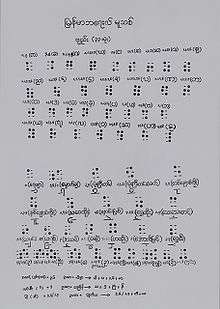Burmese Braille
| Burmese Braille Karen Braille | |
|---|---|
 | |
| Type | |
| Languages | Burmese, Karen |
Parent systems |
Braille
|
Print basis | Burmese alphabet |
Burmese Braille is the braille alphabet of languages of Burma written in the Burmese script, including Burmese and Karen. Letters that may not seem at first glance to correspond to international norms are more recognizable when traditional romanization is considered. For example, သ s is rendered ⠹ th, which is how it was romanized when Burmese Braille was developed (and is how it often still is romanized); similarly စ c and ဇ j as ⠎ s and ⠵ z.
The first braille alphabet for Burmese was developed by a Father Jackson ca. 1918.[1] There was no provision for the voiced aspirate series of consonants (gh, jh, dh, bh), nor for the retroflex (tt etc.), and Jackson provided distinct letters for complex onsets such as ky, hm and for various syllable rimes (ok, ein, aung, etc.), with no regard to how they are written in the print Burmese alphabet. These aspects have all been changed, as have several of the letters for the values which were retained. However, some of the old letters, unusual by international standards, remain, such as ⠌ for င ng and ⠪ for ီ i.
Print letters
The letters in print Burmese transcribe consonants and, in syllable-initial position, vowels. The consonants each have a corresponding letter in braille, but the initial (stand-alone) vowels in print are in braille all written ⠰ plus the letter for the appropriate diacritic (see next section). The consonant ny has two forms in print which are distinct in braille as well.[2][3]
Braille 









Print က ခ ဂ ဃ င စ ဆ ဇ ဈ ည Roman k kh g gh ng c ch j jh ny Braille 









Print ဋ ဌ ဍ ဎ ဏ တ ထ ဒ ဓ န Roman tt tth dd ddh nn t th d dh n Braille 









Print ပ ဖ ဗ ဘ မ ယ ရ လ ဝ သ Roman p ph b bh m y r l1 w s Braille 




Print ဟ ဠ အ (initial
vowel)ဉ Roman h l ' -ny-
Stacked consonants
The stacking of consonants (conjuncts) in print is indicated with ⠤ in braille. That is, Burmese Braille has two viramas, one corresponding to print virama (see next section), and one corresponding to stacking. For example, ကမ္ဘာ kambha "world" is written ⠅⠍⠤⠃⠁.[4]
Print diacritics
The diacritics in print, which transcribe both vowels and consonants, are rendered as follows in Karen Braille.[3]
| Braille | |
|
|
|
|
|
|
|
|
|
|
|---|---|---|---|---|---|---|---|---|---|---|---|
| ာ | ါ | ိ | ီ | ု | ူ | ေ | ဲ | ? | ံ | င်္ | |
| Roman | -a[5] | -i. | -i | -u. | -u | -e | -ai: | [6] | -m | -ing | |
| Braille | |
|
|
|
|
|
|
|
|---|---|---|---|---|---|---|---|---|
| ျ | ြ | ် | ွ | ှ | ့ | ◌း | (initial vowel) | |
| Roman | -y- | -r- | (virama) | -w- | h- | -.[7] | -:[8] |
⠰ is used to mark syllable- or word-initial vowels, which have distinct letters in the Burmese print alphabet. For example,
| braille | ⠰⠑ | is print | ဥ u., |
| ⠰⠑⠪⠆ | = | ဦး u:, | |
| ⠰⠱ | = | ဧ e, | |
| ⠰⠊ | = | ဣ i., | |
| and | ⠰⠪ | = | ဤ i. |
Punctuation
The following punctuation is specific to Burmese. (See Burmese alphabet#Punctuation for an explanation.) Western punctuation presumably uses Western braille conventions.
| Braille | | | | |
? | ? |
|---|---|---|---|---|---|---|
| ၍ | ၏ | ၌ | ၎င်း | ၊ | ။ | |
| Roman | (..and..) | . | @ | (ditto) | , | . |
References
- ↑ World Braille Usage, UNESCO, 1954.
- ↑ World Braille Usage, UNESCO, 2013
- 1 2 Karen Braille chart Archived November 9, 2013, at the Wayback Machine. at the LoC
- ↑ The sources used for this article are not explicit on the order of the braille letters.
- ↑ Low tone
- ↑ Labeled as a visarga, like ⠆ ◌း. However, it looks like the virama ်.
- ↑ Creaky tone
- ↑ High tone